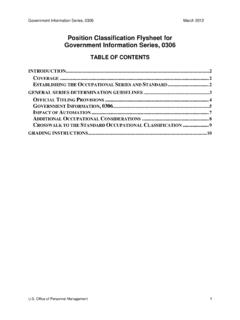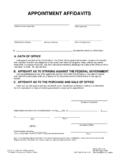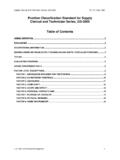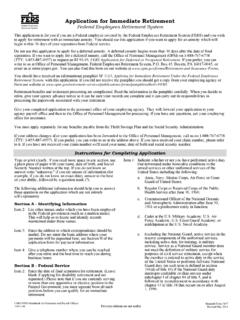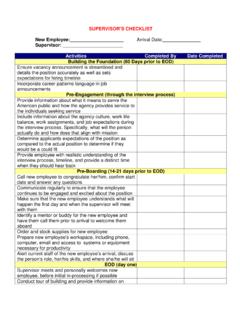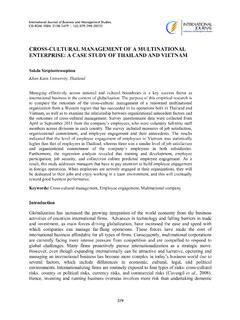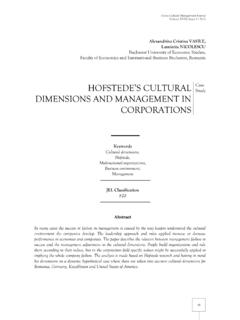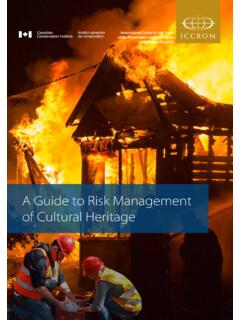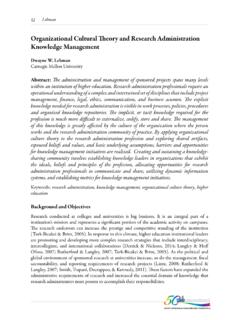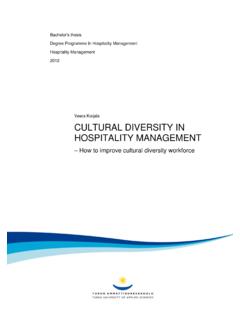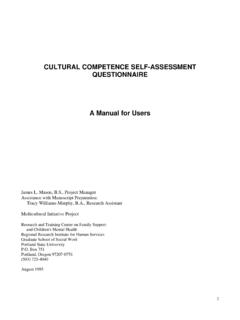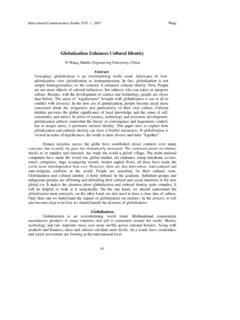Transcription of Guidance for Change Management in the Federal Workforce
1 Guidance for Change Management in the Federal Workforce Accelerating the Gears of Transformation TABLE OF CONTENTS Introduction .. 3 Creating Change .. 4 1. Develop Strategic Objectives and Specific Future Human Capital Requirements .. 6 2. Conduct Workforce Analysis .. 8 3. Consider Scenarios and Decide on a Path .. 9 4. Plan for Structural and cultural Change .. 12 Transformation through Ongoing Human Capital Strategies and EvaluationProcesses .. 15 Guidance for Change Management in the Federal Workforce 2 INTRODUCTION Under the Guidance of M 17 22 Comprehensive Plan for Reforming the Federal Government and Reducing the Federal Civilian Workforce , Federal agencies are reevaluating how to conduct operations, leveraging technology and automation, reshaping themselves to achieve those goals, and transforming their approach to human capital resources in order to most effectively and efficiently serve the American people.
2 During the reshaping evaluation process, agencies are considering organizational options including: Streamlining similar or related functions, Eliminating non core functions (to the extent permissible by law), Separating strategic from operational lines of work, Improving coordination and information sharing relationships between functional areasand refining business processes, Redefining the purpose of headquarters operations and the relationship betweenheadquarters and field operations, and Supporting program areas by centralizing mission support operations or leveraginggovernment wide solutions for support services including shared service centers andexternal service achieve the necessary changes, current Federal workers may be reskilled and redeployed across functional lines, across geographic space or both. The desired outcomes may include cost savings, improved service delivery and program outcomes, and improved customer service.
3 But this evaluative process also has the potential to fundamentally Change the way the agency views staff, skills and the human resources Management processes that are required to support its performance objectives. Guidance for Change Management in the Federal Workforce 3 5. Manage Transformation through Ongoing Human Capital Strategies and Evaluation Processes ansformation through Ongoing Human Capital Strategies and Evaluation CREATING Change To assist agency leaders in determining a strategic direction, the following set of steps outline a process to facilitate a successful physical and cultural transition for the Workforce . Many of these steps mirror the OPM Workforce Planning Model, but also factor in important decision points to approach transformation and manage Change . StrategicManage TrProcesses Objectives and Human Capital Requirements for Structuraland cultural Change Guidance for Change Management in the Federal Workforce 4 Transformationthrough Ongoing HumanCapital Strategies and Evaluation Processes 3.
4 Consider Scenariosand Decide on a WorkforceAnalysis Transformation Team The success of any corporate restructuring or relocation project depends upon the close coordination of many key contributors including: Agency Leadership: Top agency officials, including the leaders of major program areas, often set the tone for Change by outlining the goals and defining the operational needs to maintain program operations and provide services to customers. CxO Council Members: These C suite leaders of support functions including the Chief Human Capital Officer, Chief Information Officer and Chief Financial Officer provide critical feedback to operationalize the strategic vision for Change and effect the desired transformation. General Counsel: Consultation with agency counsel provides valuable advice to assist the agency in meeting its legal obligations while transforming the way missions are delivered. Human Resources Consultation: Transformations that impact the Workforce will be guided by Human Resources to provide important Workforce data to base decisions upon, recommend human capital solutions, and track progress towards the new structure.
5 Key Resource Documents The documents listed below form the basis for Change and serve as resources in the steps that guide the path to Change . Agency Reform Plan, Strategic Plan and Supporting Metrics: Together, these documents outline the desired objectives and outcomes that agency leaders are working towards between in the upcoming fiscal years. Budget, Acquisition, IT and Staffing Plan: These plans detail how financial and human capital resources will be used to achieve strategic goals and meet its performance objectives. Human Capital Operating Plan (HCOP): The annual HCOP specifies how human capital functions like hiring and training will be utilized to fulfill agency mission requirements. Guidance for Change Management in the Federal Workforce 5 1. Develop Strategic Objectives 1. DEVELOP STRATEGIC OBJECTIand Human Capital Requirements VES AND SPECIFIC FUTURE HUMAN CAPITAL REQUI When contemplating significant changes like restructuring, relocation and reskilling, the initial impetus for Change may already be defined in agency planning and performance documents, such as new goals in the agency strategic plan or shifting budget requirements in budget documents.
6 However, many other internal and external factors will influence the implementation of any Change effort. Before drafting an action plan for Change , further exploration of these drivers and how they interrelate will clarify the agency s vision for Change with a strong focus and specific objectives. To prepare, the transformation team of agency leaders and strategic partners (including executive leaders, information technology leaders, financial/budget leaders and human resources leaders) will need to gather more information and conduct additional research on the driving forces through the use of surveys, strength weaknesses opportunities threats (SWOT) analysis, forecasting, trend analysis, and interviews with internal and external Internal Factors Changes to business plans, Budget changes, Planned capital enhancements to technology, Servicing arrangements, Organizational performance, and Customer feedback External Factors Predictions about the demand for services, Societal changes, Labor market forces, and Technological innovations Guidance for Change Management in the Federal Workforce 6 stakeholders.
7 This research and initial analysis is also the first step in the Workforce analysis process. The subsequent steps will use this rationale for Change to identify new requirements, create a baseline assessment of human capital resources, and identify the gap between the supplied and needed resources. Additional human capital plans and strategies may be needed to address these concerns. Key Questions to Develop the Strategic Vision Forward Is a process in place to coordinate with all key stakeholders in the transformation effort? What is the agency s strategic direction for the short term (1 3 years) and long term (4 5 years)? How well positioned is the agency to adapt to Change ( , increase/loss of partners, budget, programs, etc.)? What are the agency s top organizational strengths and challenges? What emerging challenges exist in the following environments? o Economic o Social o Environmental o Legislative What are the agency s anticipated sources of program funding for the next 1 3 years?
8 What program changes are expected over the next 5 years? What will drive these changes? Are business and program plans aligned to the agency s mission and strategic direction? Guidance for Change Management in the Federal Workforce 7 2. CONDUCT Workforce ANALYSIS Workforce AnalysisThe second step of the Workforce analysis process is to identify the human capital already at work to meet organizational goals. With the support of Human Resources staff, agency leaders can develop and use human capital analytics to get an initial assessment of the current Workforce and the organizational structure in order to better understand their human capital and identify places for necessary changes. Sources of data may include:11 M 17 22, Appendix 6: Data Sources includes a useful list of reference materials agencies should refer to during this step Personnel data, Position descriptions and job analysis, Focus groups and workshops, Federal Employee Viewpoint Survey(FEVS) and other surveys, Competency assessments, Subject matter experts, and Process maps of organization functionsand information will be used to create Workforce metrics that can be used in subsequent steps to identify concerns and design an effective and efficient organization, such as: Position information: occupations(including whether it is mission critical),grade level, full performance level,geographic location, supervisor ratios Current and projected employmenttrends.
9 Headcount, retirement eligibility,separations, hiring, retention rates Competency assessmentsGuidance for Change Management in the Federal Workforce 8 Key Questions to Evaluate the Workforce Is the agency achieving goals andobjectives? If not, why? Whatfunctions can be consolidated orperformed through othermechanisms like private sectorcontracts? Does the agency have anoverarching Workforce strategy? What Workforce metrics aretracked? Are these metricsreviewed quarterly with keyagency stakeholders as a part ofthe agency performance Management process? What do the retirement andturnover trends reveal? How willorganizational performance beimpacted by attrition and/orretirements? What talent is mobile and able tomove across organizational linesto new functions and roles? What are the results from theFEVS? What are the areas ofstrength? What challenges arerevealed and how are these issuesbeing addressed? What employee developmentefforts are in place to maintainemployee skills and developcompetencies to address futureagency challenges?
10 What knowledge transfer effortsare in place to captureinstitutional knowledge? 3. CONSIDER SCENARIOS AND DECIDE ON A PATH 3. Consider Scenarios and Decide on a Path In many cases, agency leaders will need to select from a variety of possible solutions that could each lead to the same desired objectives. The active participation of all transformation team members is required to thoughtfully consider and analyze these competing options to further evaluate the internal and external factors identified in the first step, evaluate the impact of transformation approaches and decide on the best path forward. Scenario Based Workforce Planning is an approach that guides transformation team members through a set of steps to test their initial Workforce analysis results by: Envisioning possible and plausible future conditions, Shifting their thinking about the external environment, Considering how future conditions will affect their organization, Thinking of alternative responses, Imagining the consequences of actions and decisions, Developing long range plans and contingency plans, Assessing ramifications for Workforce and competency requirements, Developing skills gap closing strategies, and Developing anticipated budgeting requirements To prepare, participants may need to enhance the strategic Guidance and Workforce analysis developed in the first two steps of the process with additional information on the driving forces involved through surveys, strength weaknesses opportunities threats (SWOT) analysis, environmental scans, forecasting, trend analysis, and interviews with internal and external stakeholders.


